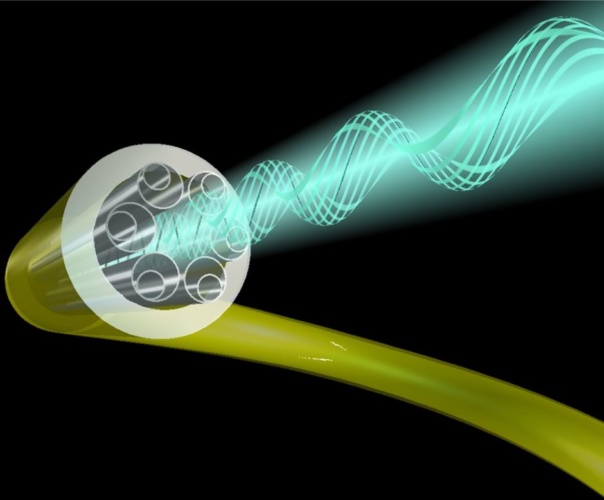
Optical fibres made of silica glass have been the transmission medium for a high-speed optical communications market estimated to be worth $40bn globally.
All-silicon optical transmitter operates at 100Gbps
The performance of optical fibres is negatively impacted by attenuation – the scattering of light inside the glass – that causes a loss in transmitted power. According to the University, this power loss limits the performance of applications requiring shorter wavelengths.
In this new study, published in Nature Communications, researchers from Southampton University have demonstrated that guiding light through air-filled fibres offers a potential way to overcome this problem.
A team from the University’s Optoelectronics Research Centre (ORC) are said to have created three different hollow core fibres, with losses comparable or lower than that achieved in solid glass fibres around technologically relevant wavelengths of 660, 850, and 1060 nanometres. The lower attenuation, in a fibre that guides light through air, offers the potential for advances in quantum communications, data transmission, and laser power delivery.
In a statement, ORC’s Professor Francesco Poletti said: “Many alternative glass types and waveguide technologies have been investigated since the 1970s to try to solve this problem, all to no avail.”
“Our findings show that hollow core fibres have the potential to outperform the current optical fibres at various wavelengths used in optical technology today. Not only do they have lower attenuation, they can also withstand higher laser intensities, such as those needed to melt rocks and drill oil wells, as well as produce more efficient lasers for manufacturing.”
Professor Poletti added that the hollow core fibres can also transmit undistorted laser pulses with peak power levels so high that they would be unusable if transmitted by standard glass fibres, and preserve the polarisation of light needed to produce more accurate sensors and imaging endoscopes.
The fibres developed and reported in the paper are the result of over ten years research by the ORC in developing Nested Antiresonant Nodeless Fibres (NANFs), special types of hollow core fibres that confine light in the central void thanks to thin glass membranes surrounding the core.
Their first fibres had attenuations of 5dB (30 per cent of light transmission), for every metre of fibre. New physical understanding with contributions from the worldwide community, and substantial development in fabrication technology led by the Southampton team, have now led one of the fibres reported in this study to improve this by a factor of 10,000 by achieving an attenuation of 5 dB every 10km.
“The technology we are developing has the potential to underpin the development of faster datacentres with shorter delays for the end-user, more accurate gyroscopes for interplanetary missions, more efficient laser-based manufacturing, to name but a few,” said Professor Poletti.
Southampton University team is continuing to work on improving the optical performance of these fibres, while producing longer lengths at a lower cost.
ORC director, Professor Sir David Payne, said: “The transmission capacity of optical fibres is so large that we never thought we’d reach the point where we would use it all up. But in the last five to ten years, we’ve realised that we’re now close to doing just that and the impact of COVID-19 has accelerated this further. This means that no longer can we tweak conventional fibres to mine more capacity but must resort to the sledgehammer approach of installing huge numbers of new fibre cables. This is possible but drives up costs.
“A faster, more reliable internet with larger bandwidth will help us sustain our current levels of online work and socialising and also enable us to take this further in areas like 3D video conferencing and virtual reality.”




Poll: Should the UK’s railways be renationalised?
I think that a network inclusive of the vehicles on it would make sense. However it remains to be seen if there is any plan for it to be for the...